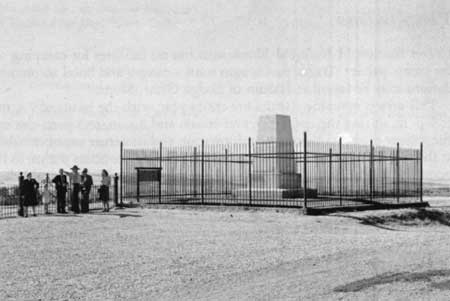|
LITTLE BIGHORN BATTLEFIELD National Monument |
 |

Memorial which stands over the grave of those slain in the Battle of the
Little Bighorn River.
How To Reach the Monument
Custer Battlefield National Monument is located in southeastern Montana about 15 miles south of the town of Hardin. It is reached from U. S. No. 87 by motorists traveling across the country, as well as from Montana State Highway No. 8, which begins just outside the battlefield and continues east and south to Broadus, Mont. It joins U. S. No. 212 leading into the northern end of the Black Hills at Belle Fourche, S. Dak.
Those who desire to travel by train may use the Chicago, Burlington amp; Quincy lines to Crow Agency, Mont., which is 3-1/2 miles from the battle field site. The American Bus Lines operate through Crow Agency on U. S. No. 87. There is no public transportation between Crow Agency and the battlefield.
The Monument
By Executive order, in 1886, the Custer Battlefield and the cemetery were proclaimed the National Cemetery of Custer's Battlefield Reservation. The name was changed to Custer Battlefield National Monument in 1946. (Web Edition Note: The name was changed to Little Bighorn Battlefield National Monument in 1991.) The monument, containing 765.34 acres, includes, in addition to the cemetery, that portion of the battlefield where the most severe fighting occurred, the ridge where Custer and his men died, and the scene of the Reno-Benteen engagement.
Administration
Custer Battlefield National Monument is a part of the National Park System belonging to the people of the United States and administered by the National Park Service of the Department of the Interior. It is under the immediate supervision of a superintendent. Communications should be addressed to the Superintendent, Custer Battlefield National Monument, Crow Agency, Mont.
Related Areas
A few other battlefields of the Indian wars, which were a part of the history of the West, have been set aside under Federal ownership for administration by the National Park Service. Also in Montana is Big Hole Battlefield National Monument, where on August 9—10, 1877, the nontreaty Nez Perce Indians, under Chief Joseph and other chiefs, over came the disadvantage of a surprise attack by troops under Colonel Gibbon. At Lava Beds National Monument, in California, are preserved the natural trenches and fortifications used by the Modocs who, in 1873, under Captain Jack, desperately resisted the efforts of troops ordered to return them to their reservation. Fort Laramie National Monument, in Wyoming, includes the site of one of the most prominent military outposts in the West.
Visitor Facilities
Custer Battlefield National Monument has no facilities for camping or for picnic parties. Trailer parks, auto tourist camps, and hotel accommodations may be found at Hardin or Lodge Grass, Mont.
This area is open for visitors the entire year, with the hours of 7 a. m. to 7 p. m. during the summer travel season and 8 a. m. to 5 p. m. during the winter months. Historical information and literature are obtainable at the museum and administration building during the hours 8 a. m. to 12 noon and 1 p. m. to 5 p. m. During the summer months, historical aides, or guides, are in attendance to conduct trips, give talks, and supply information to the public.

|
|
Last Modified: Sat, Sep 28 2002 10:00:00 pm PDT |


